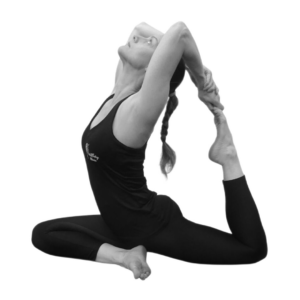
Founder of Wellbeing Winnie, Author of 'You Body Is Listening'
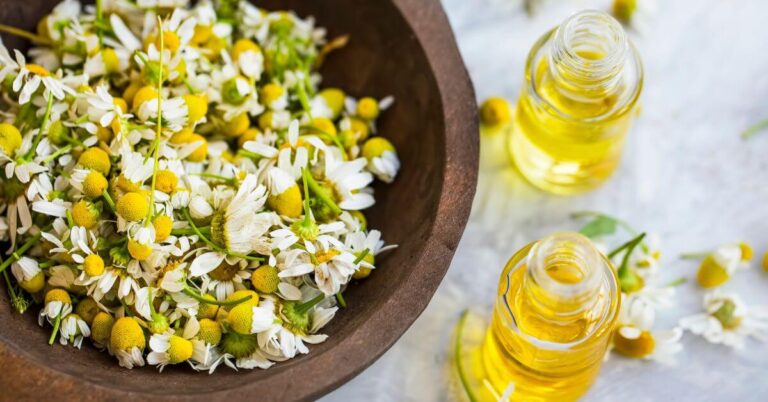
Embracing Chamomile:
These flowers are not just beautiful additions to gardens and fields but also have diverse practical uses. They are found all over the world and provide economically important resources such as cooking oils (like sunflower oil), and sweetening agents.
Chamomile belongs to the daisy family and is a composite flower (A flower that is made up of multiple simpler flowers). As such, it boasts a daisy-like, disc-shaped flower head. This flower head comprises many tiny disc florets, which make up the yellow centre, and ray florets, which are the white petals. Chamomile leaves are notable for their small size, feathery texture, and deeply divided form.
The name “daisy” has its roots in the Old English term “Day’s Eye,” reflecting the flower’s tendency to close its petals at night and open them again under the light of day.
Interestingly, chamomile tea consumption varies based on the time of day. Drinking it at night can promote relaxation and tranquillity, aiding in a restful night’s sleep, while consuming it in the morning can help awaken the senses, energize the body, and set a positive tone for the day, reducing stress levels.
The mirroring effect observed can be attributed to a concept known as “The Doctrine of Signatures.” which is a concept dating back to the times of Dioscorides and Galen (Greek physicians who practised medicine and recorded their discoveries. 1493–1541). The theory proposes that the appearance of an herb can indicate its medicinal use. According to this doctrine, herbs resembling various body parts can be employed by herbalists to treat ailments of the corresponding body parts.
However, it is a theory that is often met with scepticism, but it aims to explain how humans initially came to recognize the medicinal properties of certain plants.
German chamomile is the more commonly used option.
In contrast to the common English daisy (Bellis perennis), whose petals have a slightly bitter taste and are frequently used as an ingredient in salads and other dishes, chamomile possesses a sweeter and more soothing flavour.
Notably, since the Egyptian era, the daisy family has been believed to possess therapeutic properties. Traditionally, it was primarily used to treat ague or fever. However, further research suggests that daisies may also have the potential to alleviate other ailments.
Properties of Chamomile include:
- Antispasmodic – suppresses muscle spasms
- Antiseptic – applied to living tissue to reduce infection or purification
- Carminative – prevents gas in the gastrointestinal tract, whilst combating flatulence and heartburn.
- Sedative – Inducing sedation, reducing irritability, calms the nervous system, aids depression and encourages sleep.
- Soothing – Stomach ache, menstrual cramps, stimulates appetite pre-meal, settles stomach post-meal and soothes sunburn.
In a study, researchers investigated the effects of chamomile tea and its key components, specifically esculetin, on the blood sugar levels of diabetic rats. Their findings indicated that esculetin effectively prevented an increase in blood sugar levels, protecting high blood sugar during a sugar-loading test.
You can learn more about this research and study here
Nevertheless, Although there are multiple benefits to embracing chamomile into your diet, there are specific cautions that need to be acknowledged before using chamomile.
Rather than resorting to scare tactics, the following information aims to be informative rather than directive. So what do we know?
Roman chamomile is believed to have properties that can stimulate uterine contractions and lead to menstrual cycle disturbances and miscarriages during pregnancy.
Cautions and Contraindications
Before Embracing Chamomile things you should know:
Roman chamomile is believed to have properties that can stimulate uterine contractions and lead to menstrual cycle disturbances and miscarriages during pregnancy. snatch back after the alarm has sounded in the morning. If you work nights then create your own adjusted routine to suit. If you must sleep in the afternoon try to reduce it over time until eventually you don’t need it.
But is this an old folk tale or does it hold some weight?
A study in Tehran in 2013 has shown that there may be some truth to this. You can read about it this study here
However, there isn’t enough reliable information to know if it is safe when applied to the skin or when inhaled during pregnancy. Therefore, we recommend that you avoid using Roman chamomile if you are pregnant. You may also find, that although the chamomile flowers is reputed as a sedative, it may encourage the need to urinate. Just something to be aware of if you are drinking this tea before bed.
Furthermore, it has reputed also to counteract other medications, blood thinning, and affect blood sugars and blood pressure. We should also include that certain allergies to flowers and medical complaints such as hay fever can also be affected through the use of this flower.
Herbal cosmetics are all the rage these days, especially among those who prefer natural alternatives to synthetic chemicals for their care.
These products provide essential nutrients for the body, promote overall health, and offer a satisfying skincare experience. Unlike synthetic cosmetics, herbal cosmetics are free from harsh chemicals and have fewer side effects, which makes them a great choice for anyone looking for a more holistic approach to beauty.
If you’re interested in using herbal remedies in your skincare and beauty routine, consider embracing chamomile as a starting point.
Why? Well, read on as we will explore the remarkable benefits of chamomile and its applications in skin care and eye care.
Chamomile is not just an herb, it’s a miracle worker! With its numerous therapeutic properties, chamomile has been cherished for centuries for its ability to soothe and heal the skin and eyes. If you’re looking for a natural, refreshing way to give your skin and eyes a boost, chamomile is the way to go. Whether you want to use it as a tea, apply it to various skin conditions, or create a soothing steam, embracing chamomile is versatile and effective way to make significant changes.
Try infusing chamomile in hot water to make a tea (which of course can be drunk), or, as it is mild on the skin, use it to soothe irritations and inflamed areas such as eczema, rashes (with unbroken skin) allergic reactions, sunburn and minor wounds.
An infusion can be made from either a good quality shop-bought tea bag, fresh or dried flowers wrapped in a muslin cloth, or in an infuser teapot.
Tea bags can also be used cold or lukewarm to Soften and soothe the dark skin under tired eyes.
Gently cleanse the delicate eye area before placing the used tea bags over closed eyes. To enhance this experience and its benefits place a rolled slightly damp wash cloth over the tea bags to add weight and pressure as if to gently massage the skin underneath.
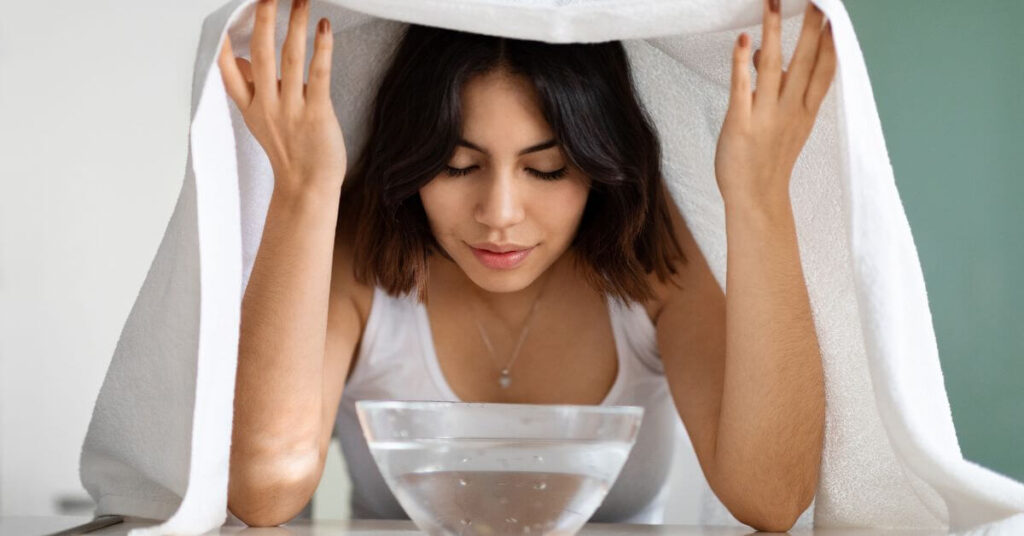
Alternatively, you can easily infuse the tea bags or loose flowers with the hot water in a bowl.
Using the steam from the infusion, position the face over the bowl and place a towel over the head. This will open the pores acting as an excellent cleanser and reducing blackheads.
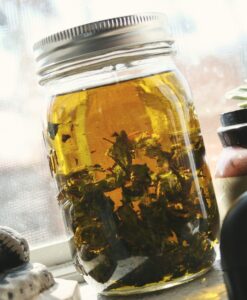
While infused oils and essential oil blends might sound similar, they are distinct. Infused oils are made by soaking flowers in a ‘carrier’ oil, such as sunflower oil (which is a good starting point for most people). The type of carrier oil you choose is a topic for another discussion. For now, let’s focus on sunflower oil as it is from the same botanical family as the chamomile flower.
Carrier oils are oils like olive, sunflower, or apricot oil. Their purpose is to dilute essential oils, making them safer for application on the skin. They also serve to carry the unique essence of the plant they originate from.
Infusions can be made using either a cold method or a heated method. For both methods, use a quantity of dried flowers equal to half a jar, and a full jar of oil of your choice.
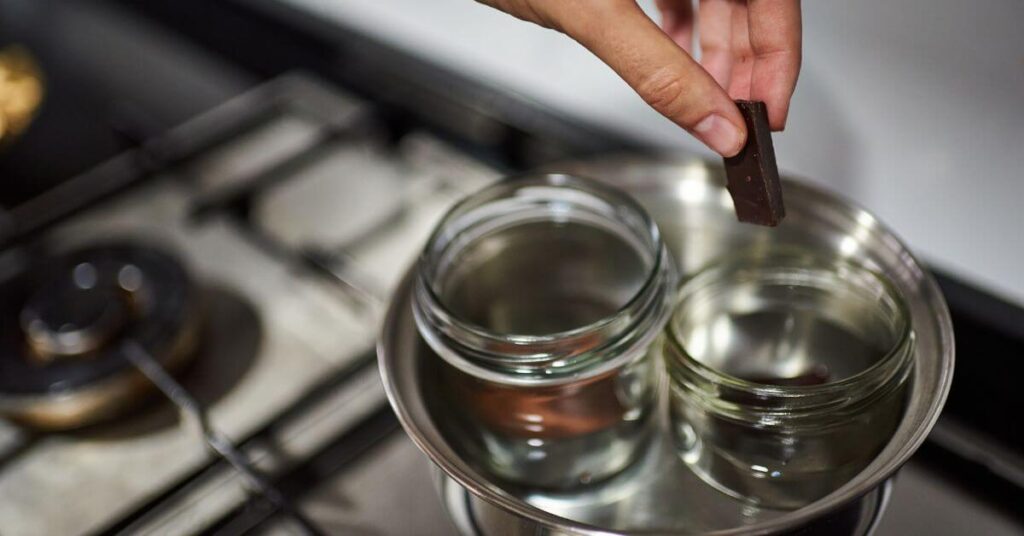
This mixture can be kept for six months in a cool dark place. Use this directly on the skin or in a balm, ointment or cream.
Just be careful not to overdo it – chamomile can lighten the skin and be photosensitive when exposed to sunlight.
Please note that the information is not a substitute for an orthodox medical and professional approach, merely a complementary therapy. Please seek professional advise if you are unsure about any of the information provided.
Teas & Hot Drinks
You can read more about this wonderful herb and others with our Treetop Teahouse ebook.
Treetop Teahouse Menu Ebook – available for download from our store here
£5.00£3.00
Ebook – Available in English and Italian
Each page will guide you through the preparation of a handful of herbal teas and includes the reputed benefits as well as contraindications.
Herbal alternatives can be very powerful. Some of the suggested teas can interfere with certain medications. Please consult your medical practitioner before starting any new healthier alternatives.
Only 14.99 per month
We are truly passionate about what we do. By offering online yoga/wellness classes and tutorials, we can be there to help you whenever and wherever you are. All our online tutorials are designed to help you understand safe movement and correct alignment. We know yoga and meditation are incredible tools for promoting health and happiness.